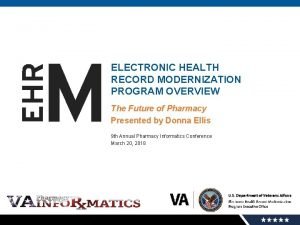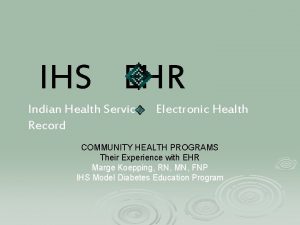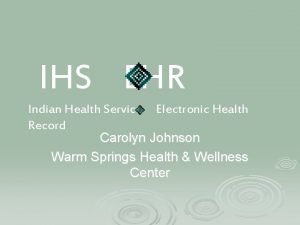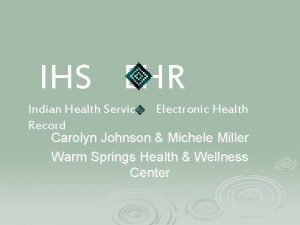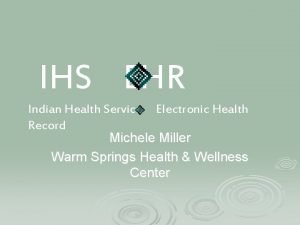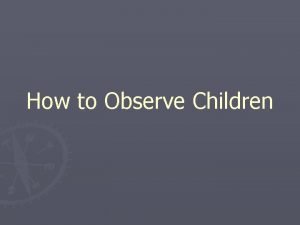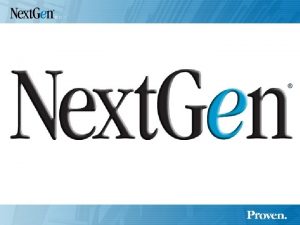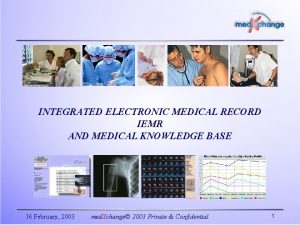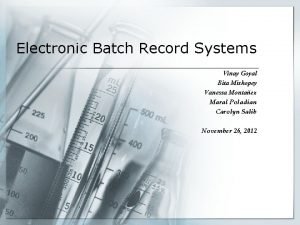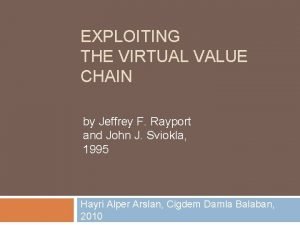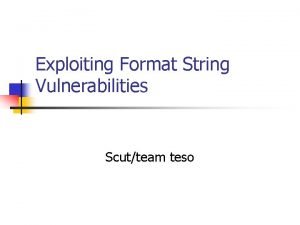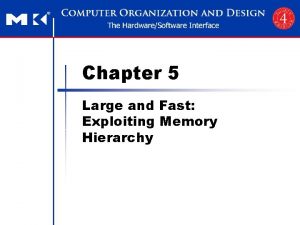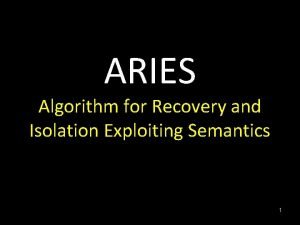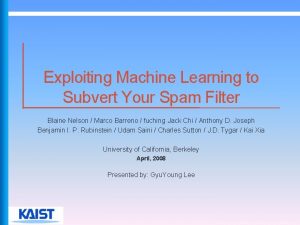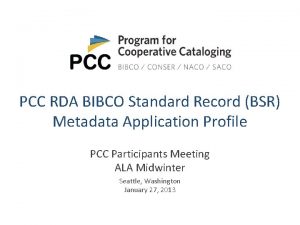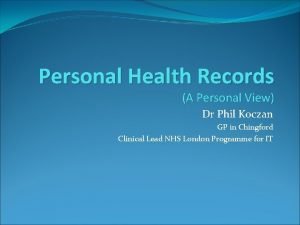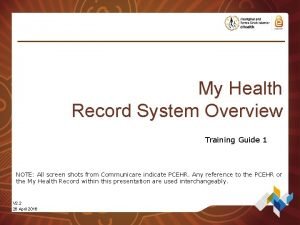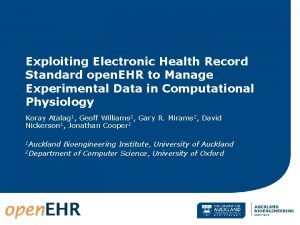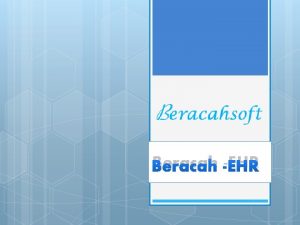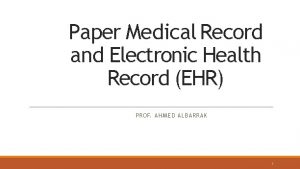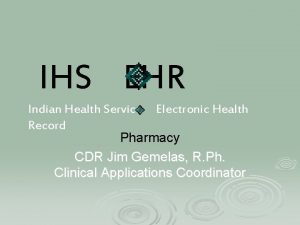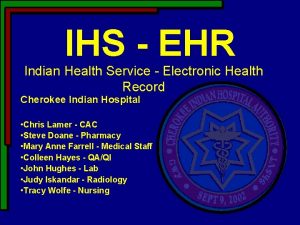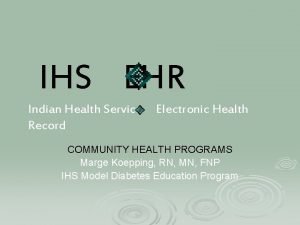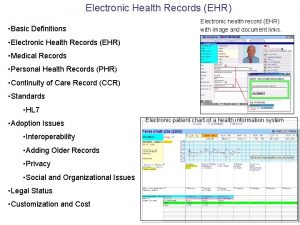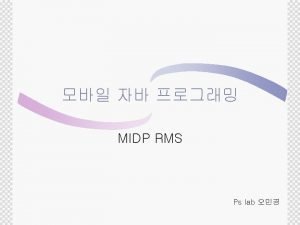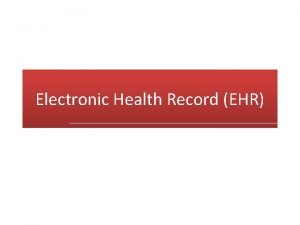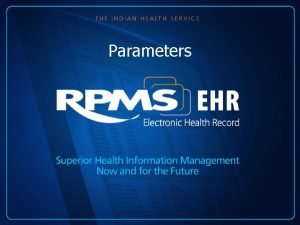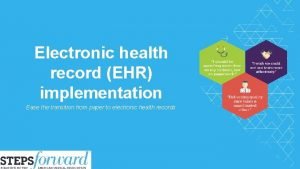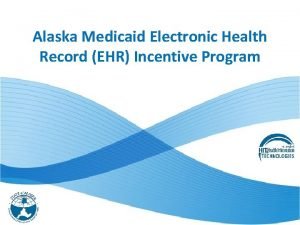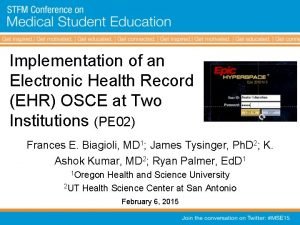Exploiting Electronic Health Record Standard open EHR to






















- Slides: 22

Exploiting Electronic Health Record Standard open. EHR to Manage Experimental Data in Computational Physiology Koray Atalag 1, Geoff Williams 2, Gary R. Mirams 2, David Nickerson 1, Jonathan Cooper 2 1 Auckland Bioengineering Institute, University of Auckland 2 Department of Computer Science, University of Oxford

Outline • Physiome/VPH & Data Linkages • Experimental Data • open. EHR fundamentals • Beyond Experimental >Health Data

Experimental Data • For Simulation Experiments mature standards (MIASE/MIBBI and COMBINE) for both data and metadata • For Wetlab Experiments there is limited agreement on standard data and meta-data formats; • Some examples (for meta-data) – – – The Cardiac Electrophysiology Ontology (EP); The Ontology for Biomedical Investigations (OBI) Just Enough Results Model (JERM) Ontology; Bioassay Ontology (BAO); ISA-Tab experimental metadata from FAIRDOM • Motivation of this study: handle experimental data and meta-data using open. EHR Information Modelling – Very flexible, model driven – Supports ontology based semantic linkages

Study Source (Wetlab) Data • Time-series type experimental data • 1 Hz steady state pacing membrane potential data from dog myocytes Johnstone RH, Chang ETY, Bardenet R, de Boer TP, Gavaghan DJ, Pathmanathan P, et al. Uncertainty and variability in models of the cardiac action potential: Can we build trustworthy models? Journal of Molecular and Cellular Cardiology • 572 traces as. csv files each containing 3248 rows of two data points: – measurement time (in seconds) – membrane potential (in volts) • No structured set of meta-data

Information Modelling (IM) Archetypes, Detailed Clinical Models, Clinical Models etc. • Computable representations of data+context = information • Define both the information structure and formal semantics of documented concepts • They facilitate: – – – Domain technical communication Managing size, complexity and changeability (of biomedicine) Organizing, storing, querying & displaying data Data exchange & distributed computing Data linkage, analytics & decision support

Clinical IM Examples: Blood Pressure Measurement mindmap representation of open. EHR Archetype

Imaging exam result mindmap representation of open. EHR Archetype

ECG recording mindmap representation of open. EHR Archetype

Study Information Model (with meta-data)

Open source specs & tooling for representing health information and building EHRs – Based on 20 years of international research – Also an ISO/CEN standard Not-for-profit organisation - established in 2001 www. open. EHR. org Extensively used in research Separation of clinical and technical worlds • Big international community • Open Access online models repository http: //openehr. org/ckm

IM: Archetypes • Constraints (OCL) on Data – – – – Structural constraints: List, table, tree What labels can be used? What data types can be used? What values are allowed for these data types? How many times a data item can exist? Whether a particular data item is mandatory Whether a selection is involved from a number of items/values • Formal semantics via terminology bindings • Flexible Meta-data definition

12 Online Model Repository

13

14

Semantics in open. EHR • Whole-of-model meta-data: – Description, concept references (terminology/ontology), purpose, use, misuse, provenance, translations • Item level semantics (Schema level) – Trees/Clusters (Structure) – Leaf nodes (Data Elements) Formally: different types of terminology bindings: 1) linking an item to external terminology/ontology for the purpose of defining its real-world clinical/biological meaning 2) Linking data element values to external terminology (e. g. a Ref. Set or terminology query) Also Instance level semantic annotations – applies to actual data collected

1) Linking data items to Ontology to define real-world meaning (~semantic annotation) mindmap representation of open. EHR Archetype

2) Linking data element values to an ontology (or subset)

Result: Experimental & Simulation Data Integration -Extended Web. Lab (doi: 10. 1016/j. bpj. 2015. 12. 012)

Conclusion • Experimental data and meta-data can be modelled using mature EHR standard – No need for a concrete persistence model – Supports model based querying – Auto-generated GUI for data and meta-data entry • Good open source tooling and data platforms • Models can be created and maintained collaboratively – Including semantic annotations – Supports provenance and version control • Same tools and methods can be used for managing real -world healthcare data

Beyond Experimental Data: Healthcare Data • Healthcare data/longitudinal EHRs are sinks of valuable knowledge/causality – Embody effects of environment/psychosocial factors • Therefore linking with EHRs will enable: – Better understanding (genotype>enviro>phenotype) – Large scale validation of computational models – Personalised computational models Predictive tools & decision support systems

Another emerging IM standard: HL 7 FHIR (Fast Healthcare Interoperability Resources) • Purpose: Information Exchange (not persistence) – Scope smaller than open. EHR – Support simpler use-cases (for exchange) • • Rapid adoption Developer oriented / pragmatic RESTful API Inspired by modern Web technologies – leveraging W 3 C standards (XML family, ATOM, RDF etc. ) • Information models defined as Resources; – Semantic linkages supported

Big Picture: Linking Computational Models to Data
 Electronic health record modernization services
Electronic health record modernization services Indian health ehr
Indian health ehr Tribal health emr
Tribal health emr Ihs ehr
Ihs ehr Tribal health ehr
Tribal health ehr Ihs ehr
Ihs ehr 영국 beis
영국 beis Specimen record observation
Specimen record observation Next gen emr
Next gen emr Integrated electronic medical record
Integrated electronic medical record How to convert paper br to electronic batch record
How to convert paper br to electronic batch record Virtual value chain
Virtual value chain Generation of a new entry opportunity
Generation of a new entry opportunity Pure-ftpd exploit
Pure-ftpd exploit Large and fast: exploiting memory hierarchy
Large and fast: exploiting memory hierarchy Aries recovery algorithm
Aries recovery algorithm Exploiting machine learning to subvert your spam filter
Exploiting machine learning to subvert your spam filter Exploiting the sponsorship examples
Exploiting the sponsorship examples Scrip exchange
Scrip exchange Electronic news gathering and electronic field production
Electronic news gathering and electronic field production Bibco standard record
Bibco standard record Personal health record definition
Personal health record definition My health record training
My health record training
